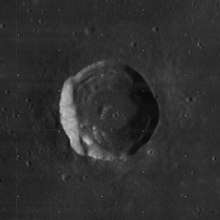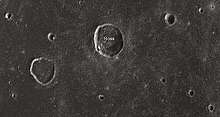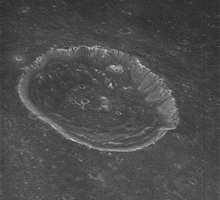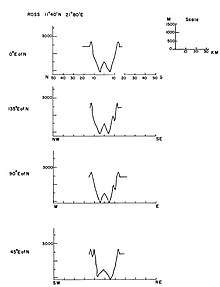Ross (lunar crater)
Ross is a lunar impact crater that is located in the northwest part of the Mare Tranquillitatis. It was named after James Clark Ross (British explorer) and Frank E. Ross (American astronomer and optician).[1] It lies south-southwest of the crater Plinius, and northeast of the lava-flooded Maclear.
 Lunar Orbiter 4 image | |
| Coordinates | 11.7°N 21.7°E |
|---|---|
| Diameter | 24 km |
| Depth | 1.8 km |
| Colongitude | 338° at sunrise |
| Eponym | James C. Ross and Frank Elmore Ross |
This crater has a generally circular shape, but is not quite symmetrical. The inner walls slope down to a base of slumped material, before joining a relatively level interior floor. There is a low ridge to the west of the crater midpoint.

Ross crater and its satellite craters taken from Earth in 2012 at the University of Hertfordshire's Bayfordbury Observatory with the telescopes Meade LX200 14" and Lumenera Skynyx 2-1
Satellite craters
By convention these features are identified on lunar maps by placing the letter on the side of the crater midpoint that is closest to Ross.

Oblique view facing south from Apollo 15

Cross sections of Ross crater with different elevations of each direction.
| Ross | Latitude | Longitude | Diameter |
|---|---|---|---|
| B | 11.4° N | 20.2° E | 6 km |
| C | 11.7° N | 19.0° E | 5 km |
| D | 12.6° N | 23.3° E | 9 km |
| E | 11.1° N | 23.4° E | 4 km |
| F | 10.9° N | 24.2° E | 5 km |
| G | 10.7° N | 24.9° E | 5 km |
| H | 10.2° N | 21.8° E | 5 km |
gollark: I saw some C in that.
gollark: Kind of. I can write simple stuff but don't know the borrow checker stuff too well.
gollark: My name predates the evils of Golang.
gollark: Nope!
gollark: In fact, it could be incredibly purely functional if nobody used it! That way no evil IO could ever occur.
References
- "Ross (lunar crater)". Gazetteer of Planetary Nomenclature. USGS Astrogeology Research Program.
- Andersson, L. E.; Whitaker, E. A. (1982). NASA Catalogue of Lunar Nomenclature. NASA RP-1097.CS1 maint: ref=harv (link)
- Bussey, B.; Spudis, P. (2004). The Clementine Atlas of the Moon. New York: Cambridge University Press. ISBN 978-0-521-81528-4.CS1 maint: ref=harv (link)
- Cocks, Elijah E.; Cocks, Josiah C. (1995). Who's Who on the Moon: A Biographical Dictionary of Lunar Nomenclature. Tudor Publishers. ISBN 978-0-936389-27-1.CS1 maint: ref=harv (link)
- McDowell, Jonathan (July 15, 2007). "Lunar Nomenclature". Jonathan's Space Report. Retrieved 2007-10-24.CS1 maint: ref=harv (link)
- Menzel, D. H.; Minnaert, M.; Levin, B.; Dollfus, A.; Bell, B. (1971). "Report on Lunar Nomenclature by the Working Group of Commission 17 of the IAU". Space Science Reviews. 12 (2): 136–186. Bibcode:1971SSRv...12..136M. doi:10.1007/BF00171763.CS1 maint: ref=harv (link)
- Moore, Patrick (2001). On the Moon. Sterling Publishing Co. ISBN 978-0-304-35469-6.CS1 maint: ref=harv (link)
- Price, Fred W. (1988). The Moon Observer's Handbook. Cambridge University Press. ISBN 978-0-521-33500-3.CS1 maint: ref=harv (link)
- Rükl, Antonín (1990). Atlas of the Moon. Kalmbach Books. ISBN 978-0-913135-17-4.CS1 maint: ref=harv (link)
- Webb, Rev. T. W. (1962). Celestial Objects for Common Telescopes (6th revised ed.). Dover. ISBN 978-0-486-20917-3.CS1 maint: ref=harv (link)
- Whitaker, Ewen A. (1999). Mapping and Naming the Moon. Cambridge University Press. ISBN 978-0-521-62248-6.CS1 maint: ref=harv (link)
- Wlasuk, Peter T. (2000). Observing the Moon. Springer. ISBN 978-1-85233-193-1.CS1 maint: ref=harv (link)
External links
- Ross at The Moon Wiki

- LTO-60B4 Ross — L&PI topographic map
This article is issued from Wikipedia. The text is licensed under Creative Commons - Attribution - Sharealike. Additional terms may apply for the media files.